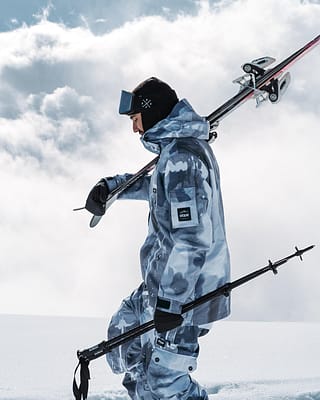How to choose ski pole length
What is the best ski pole length? Should you go for a fixed or telescopic pole? Aluminum or carbon? No dramas – Dope Mag’s got you with our whistle-stop guide.

Ski poles. They’re an essential part of our winter setup, boosting balance and mobility on the hill. Sure, you see little kids learning without them. But, as you progress, they’re 100% needed to tackle steeper slopes, maintain your turn rhythm…and shoot past your snowboarder friends on flat sections. Oh, ski poles are also handy for dragging said snowboarder friends on flat terrain, so they don’t have to unclip.
So, how do you decide which ones to go for? And – more importantly – the right size poles for you? Stick around to read our quick-fire guide and screenshot-ready size chart. Once you’ve got the lowdown, why not complete your winter look? Explore our new collection and find the perfect essentials to elevate your outfit.
Size guide
What are the different types of ski poles?

A ski pole’s just a ski pole, right? Nope! It’s always handy to think of the terrain you’re about to ride – and whether the pole in your hand can handle it. If it can’t, switch it up depending on how you ride. Of course, the main options are fixed ski poles or telescopic. But when is one better than the other? And which other ski poles exist? Let’s find out!
Fixed
A ‘fixed’ ski pole means it’s unadjustable. These tend to be the most common choice for riders as they can meet most of your alpine needs. And, spoiler alert, our size guide below tells you the best size for your fixed length.
Fixed-length poles have a straight, durable shaft and can handle slopes and off-piste. Which material, grip, and basket combo you want is completely up to you. Don’t worry – we’ll get onto all that stuff in a second.
Telescopic
Telescopic ski poles are adjustable or extendable, meaning you can switch up the height. If powder is your paradise (and why wouldn’t it be!?), you might want telescopic poles to skin up and hunt for freshies.
Yep, these versatile poles are particularly handy when earning your turns and out in the backcountry. That’s because you can lengthen or shorten them on the uphill (depending on the steepness and gradient) and change them to a regular length on the descent.
Racing
Ski racing poles are typically super lightweight for skiing like the wind without being weighed down. That doesn’t mean they’re fragile, though! Yep, ski racers’ poles are incredibly durable for aggressive turns and gate or slalom pole clips. Many racing poles have a guard attached to the grip to help deflect those gates. You’ll also notice they have smaller, slightly domed baskets to enhance their aerodynamic design and avoid catching.
Alpine ski racing poles are often straight for slalom courses. However, for downhill races and giant slalom (GS) courses, there’s a curve in the shaft. This shape minimizes drag by contouring around the racer’s body when they’re in a tucked position.
Freestyle
If you do hit the park with poles, it’s down to preference whether you want fixed or telescopic ones. Remember, they have to be super durable to handle impact against features (and maybe a bail or two).
Spend a lot of time in the air? Shorter poles are usually the park rat’s stick of choice. No one wants lengthy sticks getting in the way as you slide rails and stomp kickers, right? In fact, some jibbers go no-pole for this very reason.
What makes a ski pole?

Think ski poles are just a simple stick? Think again. Each one has different parts and materials to withstand bails and yard sales. They must also be durable enough for you to plant your turns without snapping and light enough to avoid any arm fatigue. Remember, light poles help you get your hands up front where they should be. We don’t want any backseat riding around here!
Grip
This is what you hold on to. Most ski poles have a wider grip at the top and bottom to keep your hand in position. The material and the shape of the grip come down to preference. For example, you can choose a rubber grip. Alternatively, a harder, plastic grip with molded grooves might feel more comfortable.
Grips are also available in extended lengths, soft cork, padded, and non-padded. So, the choice is up to you! It all comes down to preference and what feels the best. Remember, you’ll hold on to these ski poles for big chunks of time, so selecting a grip that you find comfy is rather important.
Strap
You put your hand through the strap so you don’t lose your pole when you fall or let go of your grip. Have you ever had to hike back up through pow to find a dropped pole? It’s like the hardest game of Where’s Waldo ever!
Strap lengths can be adjustable. A selection of poles feature detachable straps, which release with a button. However, not all skiers use straps, and some prefer to shred without them. Again, it’s all down to preference and what works for you.
Basket
Baskets are the plastic discs at the end of your ski pole, just above the tip. Think of them like a snowshoe – there to stop your poles sinking too far into the white stuff. A standard-sized basket is typically around 5 cm/2 inches in diameter.
However, if you’re a true powder hound, hunt for a larger basket with a greater surface area (around 10 cm/4 inches in diameter). This helps your poles stay afloat in waist-deep freshies. You can also find interchangeable or replaceable baskets – perfect if you want to switch things up or accidentally break your current ones.
Shaft
The shaft is the main ‘stick’ part of the pole. Most are made from aluminum, carbon fiber, composite, or bamboo. And each one has pros and cons. Let’s take a look, shall we?
Aluminum ski poles: This is the most common pole material – the popular kid if you will. That’s because of their high strength-to-weight ratio and reliable performance. If you’re a frequent shredder, aluminum is a good bet – it can handle repetitive use, Tomahawks, rail slams, and more.
Carbon ski poles: These are super responsive and ultra-lightweight. And for that reason, you’ll notice they’re massively increasing in popularity (watch out, aluminum!). Ski tourers are big fans of carbon, as they can earn their turns without lugging much extra weight on the ascent. If you’re an aggressive skier, choose aluminum poles, which are often more durable.
Composite ski poles: These are great for hardpack (we’re looking at you, East Coast) and the backcountry as they’re made from various specialized materials (such as fiberglass, graphite, or carbon fiber). This gives them increased durability, plenty of shock absorption, and tons of flexibility. By flexibility, we mean some composite poles bend when you push on them but snap right back to straight! They’re often pricier than your good ol’ aluminum poles, though.
Bamboo ski poles: These blend flexibility with rigidity and are less likely to bend or snap than their aluminum or carbon fiber counterparts (although that takes a lot to do!). Okay, bamboo poles aren’t the most common type in the lift line. However, they’re slowly gaining popularity thanks to their eco-friendly, sustainable construction and reliable performance.

Ski pole size chart
Now to the juicy part: our downhill ski pole size chart! Compare your height to the pole length, and you should be good to rip. Oh, and don’t forget you’ll be in your ski boots, which always add a bit of extra height.
In between two sizes in the chart? Go for the shorter length! They’re easier to control and give you a greater range of motion, so you can carve, cruise, and charge the whole mountain.
| Skier Height (Inches and cm) | Pole length (Inches and cm) |
| 4'9" - 5'0" (145-152.5 cm) | 42" (107 cm) |
| 5'1" - 5'3" (156-160 cm) | 44" (112 cm) |
| 5'4" - 5'6" (162.5-168 cm) | 46" (117 cm) |
| 5'7" - 5'9" (170-175 cm) | 48" (122 cm) |
| 5'10" - 6'0" (178-183 cm) | 50" (127 cm) |
| 6'1" - 6'3" (185.5-190.5 cm) | 52" (132 cm) |
| 6'4" - 6'6" (193-198 cm) | 54" (137 cm) |
| 6'7"+ (200 cm+) | 56" (142 cm) |
How to measure your ski pole without a chart
In a store and unsure of your ski pole size? Grab the one you like the look of, turn it upside down, and grip it under the basket. If it’s the correct size, your arm will bend 90 degrees with your elbow sitting comfortably on the top of your hip. Boom – you’ve found your match!
You might find your preference for longer or shorter poles change over time. However, this 90-degree rule is an awesome starting point, especially for your first pair of poles.
Wrapping up
Well, what do you know? It turns out that choosing ski poles needs some thought behind it. However, choose the correct length set of poles, and you’ll have the balance, rhythm, and support on the hill (and liftoff on flat sections) to make your riding even better.
Want to hear our crew’s favorite ski poles? Or have a question about which ski jacket is the perfect shade for your new sticks? Shoot us a message at crew@dopesnow.com or say hello via our online chat service.
Related reading:


